Related Research Articles

Blue is one of the three primary colours in the RYB colour model, as well as in the RGB (additive) colour model. It lies between violet and cyan on the spectrum of visible light. The term blue generally describes colors perceived by humans observing light with a dominant wavelength between approximately 450 and 495 nanometres. Most blues contain a slight mixture of other colours; azure contains some green, while ultramarine contains some violet. The clear daytime sky and the deep sea appear blue because of an optical effect known as Rayleigh scattering. An optical effect called the Tyndall effect explains blue eyes. Distant objects appear more blue because of another optical effect called aerial perspective.

Ultramarine is a deep blue color pigment which was originally made by grinding lapis lazuli into a powder. Its lengthy grinding and washing process makes the natural pigment quite valuable—roughly ten times more expensive than the stone it comes from and as expensive as gold.
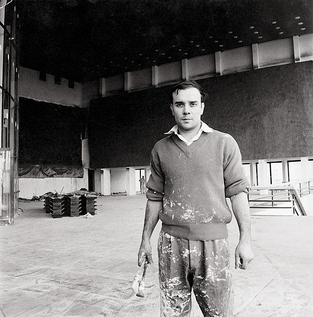
Yves Klein was a French artist and an important figure in post-war European art. He was a leading member of the French artistic movement of Nouveau réalisme founded in 1960 by art critic Pierre Restany. Klein was a pioneer in the development of performance art, and is seen as an inspiration to and as a forerunner of minimal art, as well as pop art. He is known for the development and use of International Klein Blue.

Monochromatic painting has played a significant role in modern and contemporary Western visual art, originating with the early 20th-century European avant-gardes. Artists have explored the non-representational potential of a single color, investigating shifts in value, diversity of texture, and formal nuances as a means of emotional expression, visual investigation into the inherent properties of painting, as well as a starting point for conceptual works. Ranging from geometric abstraction in a variety of mediums to non-representational gestural painting, monochromatic works continue to be an important influence in contemporary art.

Grisaille is a painting executed entirely in shades of grey or of another neutral greyish colour. It is particularly used in large decorative schemes in imitation of sculpture. Many grisailles include a slightly wider colour range.

Nouveau réalisme is an artistic movement founded in 1960 by the art critic Pierre Restany and the painter Yves Klein during the first collective exposition in the Apollinaire gallery in Milan. Pierre Restany wrote the original manifesto for the group, titled the "Constitutive Declaration of New Realism," in April 1960, proclaiming, "Nouveau Réalisme—new ways of perceiving the real." This joint declaration was signed on 27 October 1960, in Yves Klein's workshop, by nine people: Yves Klein, Arman, Martial Raysse, Pierre Restany, Daniel Spoerri, Jean Tinguely and the Ultra-Lettrists, Francois Dufrêne, Raymond Hains, Jacques de la Villeglé; in 1961 these were joined by César, Mimmo Rotella, then Niki de Saint Phalle and Gérard Deschamps. The artist Christo showed with the group. It was dissolved in 1970.
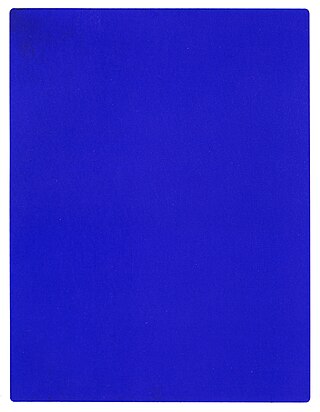
International Klein Blue (IKB) is a deep blue hue first mixed by the French artist Yves Klein. IKB's visual impact comes from its heavy reliance on ultramarine, as well as Klein's often thick and textured application of paint to canvas.
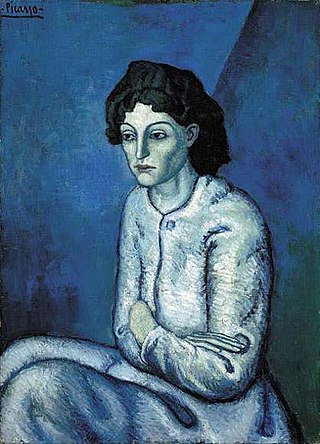
Femme aux Bras Croisés, is an oil on canvas painting by Pablo Picasso, which he created between 1901 and 1902 during his Blue Period. The subject of the painting is unknown, but she is considered to be an inmate of the Saint-Lazare hospital-prison in Paris. The painting is listed as one of the most expensive paintings after it achieved a price of $55 million at Christie's auction on 8 November 2000.
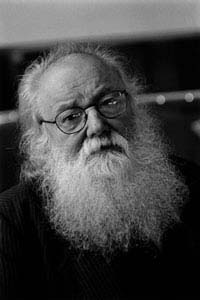
Pierre Restany, was an internationally known French art critic and cultural philosopher.

The Iris Clert Gallery was an art gallery named after its Greek owner and curator, Iris Clert. The single-room gallery The Iris Clert Gallery was an art gallery named after its Greek owner and curator, Iris Clert. The single-room gallery was located on 3 rue des Beaux-Arts in Paris, France. It was open from 1955 to 1976 and during that time housed artworks from many successful and influential artists of the time, including Yves Klein, Jean Tinguely, Arman, Takis and René Laubies.was located on 3 rue des Beaux-Arts in Paris, France. It was open from 1955 to 1976 and during that time housed artworks from many successful and influential artists of the time, including Yves Klein, Jean Tinguely, Arman, Takis and René Laubies.

Yves Peintures is an artist's book by the French artist Yves Klein, originally published in Madrid, on 18 November 1954. This publication was Klein's first public gesture as an artist, featuring pages of 'commercially printed papers' that were seemingly reproductions of paintings that, in fact, didn't exist. Using a practice started by Marcel Duchamp, this use of readymade objects to represent nothing but themselves has been referred to as an early example of Postmodernism, using a series of carefully executed strategies to undermine its own authority, and as a precursor to conceptual art. 'The simplicity of his readymades is at once sublime and mischievous.'
"The booklet asserts its character straightaway in the preface: a wordless text of unbroken horizontal lines with the same two paragraph indentations on each page.... a homogenous continuum with no real beginning, middle, or end, and no content - at least insofar as there are no descriptions, analyses, or personalized utterances. The colour plates are similarly presented as anonymous entities, each a flat spatial field of an uninflected hue: turquoise, brown, purple, green, pink, gray, yellow, ultramarine, mint, orange, or red. Here, too, there is no attempt to represent or symbolize anything....
The booklet thus offers an utterly pared down presentation. Unlike most art books, it provides no reverential prose about the artist or the art, and no embellishing descriptions meant to convey meaning or context. Instead the booklet itself is made into a work of art that shares the same spirit of nothingness exemplified by the monochrome paintings that it features." Sidra Stich

Dimanche (Sunday), also known as Dimanche - Le Journal d'un Seul Jour is an artist's book by the French artist Yves Klein. Taking the form of a 4-page Sunday broadsheet, the piece was published on Sunday 27 November 1960 and sold on newsstands throughout Paris for one day only, as well as being handed out at a press conference held by Klein at the Galerie Rive Droite at 11.00am on the same day.
Martial Raysse is a French artist and actor. He lives in Issigeac, France. He holds the record for the most expensive work sold by a living French artist.

Zone de Sensibilité Picturale Immatérielle is an artist's book and performance by the French artist Yves Klein. The work involved the sale of documentation of ownership of empty space, taking the form of a receipt, in exchange for gold; if the buyer wished, the piece could then be completed in an elaborate ritual in which the buyer would burn the receipt, and Klein would throw half of the gold into the Seine. The ritual would be performed in the presence of an art critic or distinguished dealer, an art museum director and at least two witnesses.

Young Girl with a Flower Basket is a 1905 oil on canvas painting by Pablo Picasso from his Rose Period. The painting depicts a Parisian street girl, named "Linda", whose fate is unknown. It was painted at a key phase in Picasso's life, as he made the transition from an impoverished bohemian at the start of 1905 to a successful artist by the end of 1906. The painting is listed as one of the most expensive paintings, after achieving a price of $115 million when it was sold at Christie's on 8 May 2018. It is currently the third highest selling painting by Picasso.
The Hôtel du département des Bouches-du-Rhône, known as Le Grand Bleu, is the headquarters and council chambers of the Conseil General of Bouches-du-Rhône in Marseille, France. The Sterling Prize-nominated building, noted for its distinct ultramarine colour, was designed by architects Will Alsop and Jan Störmer as the new regional government headquarters. Located north of Marseille's city centre, in the Saint-Just district, the High-Tech structure was designed to combine dispersed administrative functions into a single site. The winner of an international architecture competition launched in 1989, which in its final round saw Alsop and John Lyall compete versus established architectural practice Foster + Partners, the Hôtel du département was designed with architectural artist Brian Clarke, who conceived the colouration and treatment of the facade as a “skin of art”. The landmark High-tech building, the largest public building to be constructed in the French provinces in the twentieth century, was built in 26 months, opening in 1994.
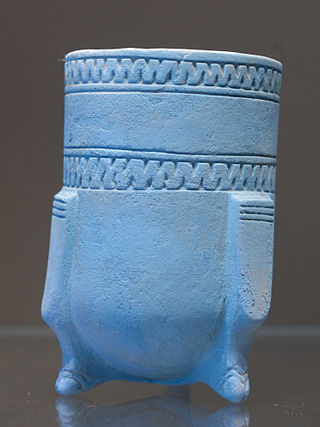
The colour blue has been important in culture, politics, art and fashion since ancient times. Blue was used in ancient Egypt for jewellery and ornament. In the Renaissance, blue pigments were prized for paintings and fine blue and white porcelain. in the Middle Ages, deep rich blues made with cobalt were used in stained glass windows. In the 19th century, the colour was often used for military uniforms and fashion.

Blue pigments are natural or synthetic materials, usually made from minerals and insoluble with water, used to make the blue colors in painting and other arts. The raw material of the earliest blue pigment was lapis lazuli from mines in Afghanistan, that was refined into the pigment ultramarine. Since the late 18th and 19th century, blue pigments are largely synthetic, manufactured in laboratories and factories.
ANT 82, Blue Age Anthropometry is a painting by French artist Yves Klein, created in 1960. Purchased in 1984, this work is part of the collection of the Musée National d'Art Moderne, in Paris.
IKB 79 is a paint on canvas on plywood painting by French artist Yves Klein, from 1959. It is one of his monochrome paintings, of which he made around 200, in the colour blue that he conceived, International Klein Blue, based on pigment ultramarine. The current painting has the dimensions of 139.7 by 119.7 cm. It is held at the Tate Modern, in London.
References
- ↑ Le Rose du Bleu, Memento, 2 September 2015
- ↑ Pierre Restany, Fire in the Heart of the Void, New York, 2005, pp. 24-26
- ↑ A look at "Le Rose du Bleu (The Pink of Blue)", (RE 22), Yves Klein website
- ↑ A look at "Le Rose du Bleu (The Pink of Blue)", (RE 22), Yves Klein website
- ↑ "The Most Expensive Yves Klein Paintings Sold at Auction". 30 September 2023.
- ↑ Yves Klein (1928-1962), Le Rose du bleu (RE 22), Christie's
